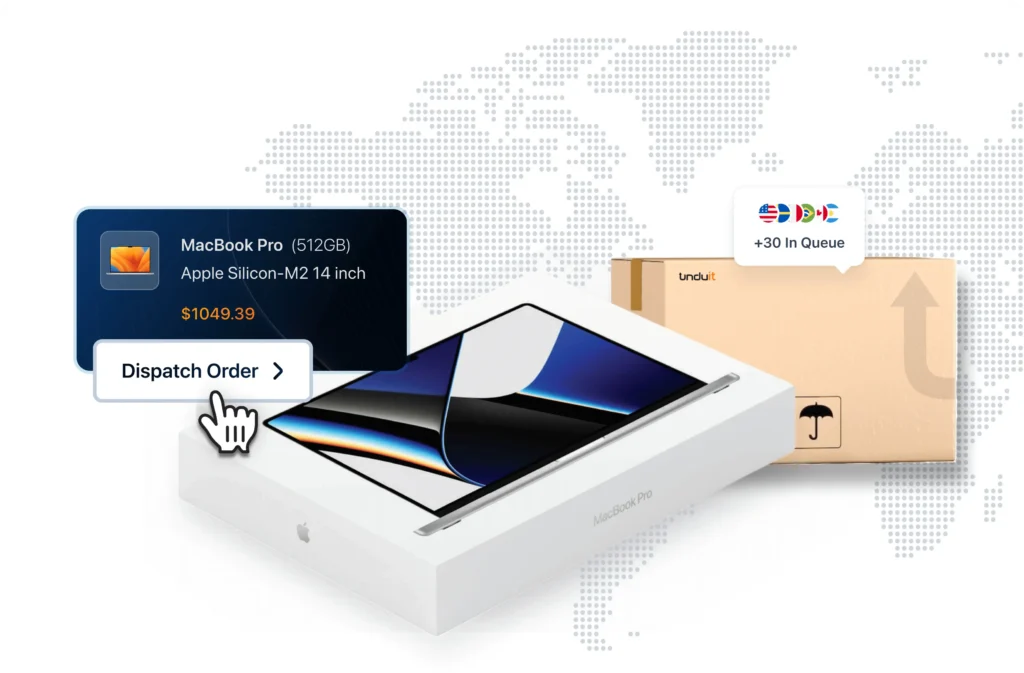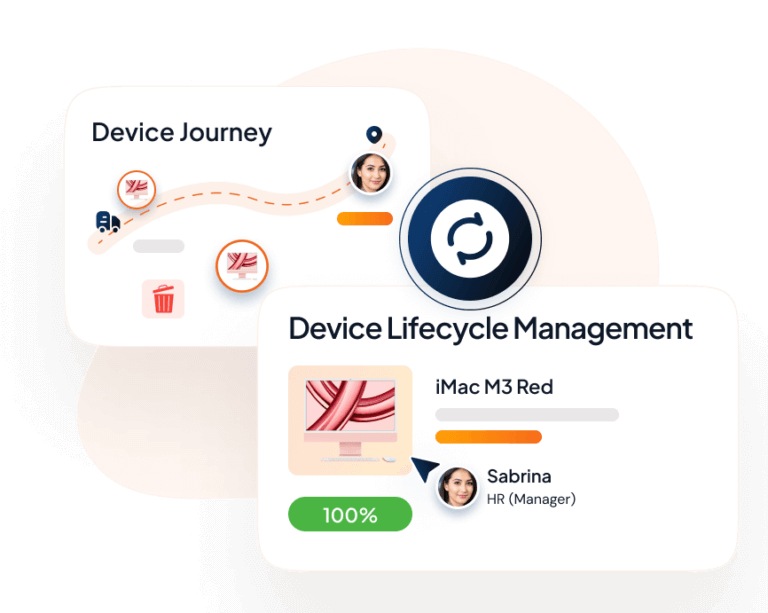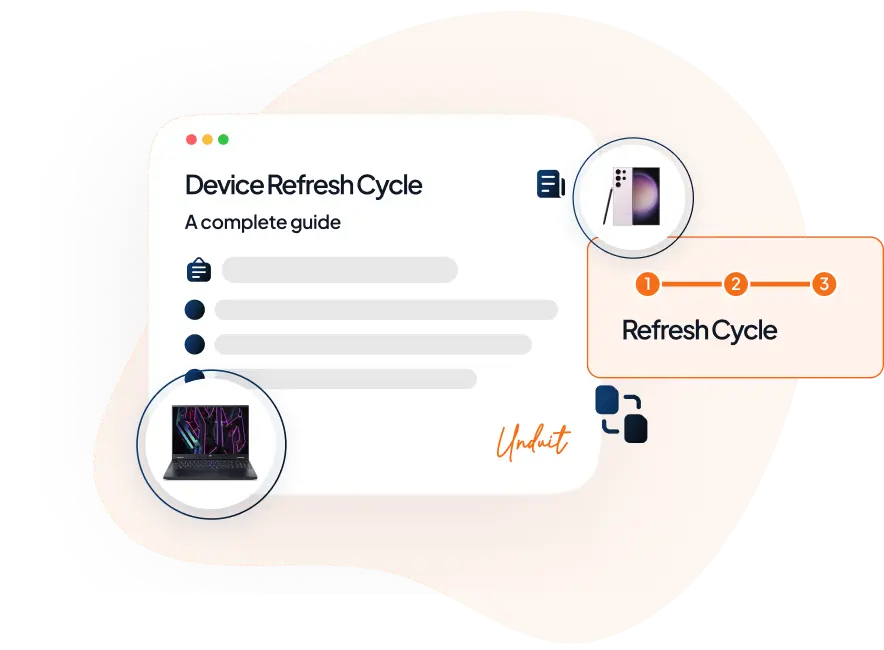Shipping laptops internationally can be a daunting task that requires careful consideration of various factors, from shipping fees, taxes, and customs charges to ensuring the safe arrival of your laptop.
Whether you are shipping your laptop from the United States to Canada or from the United Kingdom to the United Arab Emirates, it is important to understand and be aware of the entire process and requirements for shipping laptops internationally. One step in the wrong direction can cost you a lot! That is why it is always recommended to take expert advice before handling such delicate matters on your own.
We have compiled a global laptop shipping checklist and this ultimate global laptop shipping guide to help you navigate the complexities of international shipping
Taxes, Customs & Landed Costs
If you have ever shipped anything internationally you know the biggest and the most complex thing to understand are the taxes, customs duties, and landed costs as these costs/fees will differ depending on each country. Here is how it works
Landed Costs
Landed costs encompass all expenses incurred by a business to ship and deliver a product, extending beyond its purchase price to cover importing, shipping, and handling. Understanding these costs is vital for precise pricing, budgeting, and decision-making in international trade. This concept applies to laptops and other goods sent to overseas employees, where additional expenses beyond the purchase cost are incurred. Total landed cost can be calculated by summing up these expenses.
Product price+Shipping cost+Duty/tax+carrier fee
De Minimis value
De minimis is a threshold that exempts imports from duty and tax/VAT. The threshold varies by country and has a significant impact on e-commerce transactions. De minimis plays a crucial role in facilitating faster clearance for lower-value transactions, providing a competitive advantage for shipments with a lower value.
De minimis applies when a company ships a laptop or other products to remote employees abroad. Certain countries offer duty-free limits for personal shipments, including laptops for employee use. If the laptop’s value falls below the de minimis threshold, it might be exempt from import duties. However, other taxes like VAT or GST could still apply based on destination country regulations.
EU member countries that use the Euro share the same de minimis value.
- Duty is exempt for values up to 150 EUR.
- VAT is always charged regardless of the value.
- Both duty and VAT are due when the value exceeds 150 EUR.
In countries like Australia and Russia, de minimis isn’t straightforward, often requiring additional conditions for specific sales volumes or weights. Despite Colombia’s tax de minimis being 0, the tax de minimis for personal shipments from the United States to Colombia is set at 200 USD.
Taxations
When a company wants to ship a laptop to their remote employee internationally, understanding the different taxation methods (VAT, GST, customs duty, and sales tax) is crucial to determine the tax implications of the transaction.
Here’s how each taxation method may apply:
VAT (Value-Added Tax) / GST (Goods and Services Tax)
VAT and GST are both forms of indirect taxes, collected throughout the supply chain. They are paid at every stage of the product life, from production to consumption, with rates determined by individual country laws. The end consumer ultimately bears the tax burden, as it is included in the purchase price.
- In international shipments, cross-border VAT/GST is usually collected by customs. The responsibility for collecting VAT may shift to sellers/businesses under new laws.
- Businesses must report and remit the tax to the relevant tax authorities, and VAT invoices must be issued within specific timeframes.
- Reclaiming VAT expenses from tax authorities varies from country to country and is typically not available for end consumers.
- If the destination country imposes VAT or GST, the company needs to consider the applicable rates and rules. The tax may be collected at the customs, and the company must report and remit the tax to the relevant authorities.
- If the laptop is being shipped to the U.S., the company needs to be aware of the specific state and local sales tax regulations. If there is no business presence in the state of the remote employee, sales tax collection may not be required.
Sales Tax (U.S.)
Sales tax is a one-time tax charged at the point of purchase in the U.S.
- It is only collected on the sale of goods to the end consumer.
- Sales tax rates, rules, and exceptions are determined at the state and local levels.
- For international sales, U.S. import sales tax is not applicable unless the seller has a nexus (business presence) in the state where the buyer is located.
- Retailers may not have to collect or remit sales tax when selling online from state to state unless they have a business presence there.
The company must grasp the precise tax regulations in both origin and destination countries, including exemptions or thresholds. Maintaining precise records and issuing proper invoices in line with relevant tax laws is crucial for compliance. Consulting tax professionals or utilizing specialized software can aid in navigating international taxation complexities.
Cost Analysis of Shipping Laptops Internationally
Let’s break down the shipping costs of laptops, covering everything from the initial purchase to taxes, giving you a clearer understanding of what to expect at each step of the process.
Detailed Breakdown of Costs
Here is a breakdown of the cost for the entire process
- Purchase cost of laptops: Average cost ranges between $1,000 and $3,000 per laptop.
- Configuring and managing costs: Includes the cost of software installation, setup, and ongoing maintenance costs. This cost will depend on the software and other services that you purchase.
- Shipping costs: Influenced by factors like package weight, size, shipment options, destination country, customs fees, and local tax policies as discussed above.
Factors Influencing Shipping Cost
Several factors can influence the cost of shipping, by controlling these factors you can control your overall shipping cost
- Package weight and size: Heavier or larger packages may incur higher shipping fees.
- Shipment options: Express shipping typically costs more than economy options.
- Destination country: Different countries may have varying customs fees and tax policies affecting shipping costs.
Estimated Delivery Times
To ensure timely delivery of laptops to your employees, it’s crucial to understand the expected shipping durations. While actual delivery times may vary, we’ve provided estimated durations from continent to continent to give you a general idea of the shipping timeframes.
- Asia: 7 business days approx.
- Europe: 7 business days approx.
- North America: 7 business days approx.
- Africa: 14 business days approx.
- Oceania: 14 business days approx.
- Latin America: 14 to 28 business days approx.
Documentation Required
Shipping a laptop internationally involves several documentation requirements to ensure a smooth and compliant process. The specific documents needed may vary depending on the countries involved and their respective regulations. Here is a general list of documentation required for international laptop shipments:
Commercial Invoice
- This document provides details about the transaction, including the laptop’s description, value, and quantity in terms of sale.
- It serves as a customs declaration and is used by customs authorities to assess duties and taxes.
Packing List
- A detailed packing list includes information about the contents of the parcel such as the laptop’s model, serial number, and any accessories included.
- It complements the commercial invoice and helps customs authorities verify the accuracy of the declared information.
Proforma Invoice
- In some cases, a proforma invoice may be required. It is a preliminary invoice provided by the seller before the shipment is made, outlining the terms of the sale.
Shipping Label
- Clearly labeled and properly addressed packaging is crucial. Include the sender’s and recipient’s addresses, contact details, and any reference numbers.
Certificate of Origin
- This document indicates the country where the laptop was manufactured. Some countries may require a certificate of origin to determine eligibility for preferential trade agreements or to assess import duties.
Customs Declaration Form
- Depending on the destination country, a customs declaration form may be required to declare the laptop’s value, purpose (e.g., personal use or commercial sale), and other relevant details.
Electronic Export Information (EEI) or Shipper’s Export Declaration (SED)
- Required for parcel from the United States, EEI or SED provides the U.S. government with information about the exported goods and is submitted through the Automated Export System (AES).
Import License or Permit
- Some countries require an import license or permit for certain goods. Check the import regulations of the destination country to determine if this is necessary for laptops.
Insurance Certificate
- If the shipment is insured, include an insurance certificate specifying the coverage and terms. This is especially important for high-value items like laptops.
Bill of Lading or Airway Bill
- For sea or air shipments, a bill of lading or airway bill serves as a receipt and contract for the transportation of the laptop. It includes details about the shipment, carrier information, and terms of delivery.
Export License (if applicable)
- In some cases, an export license may be required, especially for goods with potential security implications. Check export control regulations to determine if an export license is needed.
Harmonized System (HS) Codes
- The Harmonized System (HS) is a globally recognized product classification system established and managed by the World Customs Organization (WCO). It offers a standardized method for categorizing traded goods and is adopted by customs authorities worldwide. Each product is designated a unique code, referred to as the HS code.
- HS codes are used on customs declarations and shipping documents to identify and classify products accurately.
- Governments can use HS codes to determine import and export duties and taxes.
It’s essential to verify the specific documentation requirements of both the origin and destination countries, as well as any transit countries, to ensure compliance with customs regulations. We suggest working with a reliable ITAD service, international shipping provider, or customs broker which can help navigate the complexities of documentation and customs procedures.
Packaging
Proper packaging not only protects against scratches and bumps but also extends the lifespan of your devices. Here are key tips for secure packing, and packing materials for international shipment of laptops:
Pack Your Laptop
- Before packing, meticulously clean the laptop, removing any dust or debris. Power down the computer entirely, and if applicable, remove the battery.
Protect The Sensitive Parts
- Cover the power and volume buttons with cardboard or electrical tape to prevent accidental power-on during transit.
- Place a thin layer of bubble wrap or foam between the keyboard and screen to shield them when the laptop is closed.
- To avoid tangling and potential damage by wrapping the laptop’s cables, plug adaptors, and accessories in bubble wrap. Secure them with cable ties and place them separately from the laptop in the shipping box.
Remove Dangerous Goods
- During electronics shipping make sure to avoid dangerous goods like shipping lithium batteries or any other inflammable electronic device. You might want to get the list of prohibited items from your postal service or shipping service providers to avoid any mishaps during the transit process.
Wrap It Up
- Use plastic or bubble wrap to wrap the laptop’s shell securely. To mitigate static electricity risks, encase the laptop in a snug-fitting plastic bag.
The Right Shipping Box
- Choose a sturdy and appropriately sized laptop box. If possible, use the original packaging from the manufacturer. If using the original box, consider double boxing for added protection. Select an outer box six inches larger in all dimensions, filling the space with packing materials like inflatable packaging, foam inserts, packing peanuts, or bubble wrap.
Fill Up The Box
- Ensure the laptop is securely packed with no room to slide during transit. Fill any empty space with additional packing materials, such as foam inserts packing peanuts or other cushioning material to hold the laptop in place.
Insurance
- Given the value of laptops, consider opting for shipping insurance to protect against damage, loss, or theft during transit. Many shipping companies offer insurance options to add for peace of mind.
Inspect Package
- Upon arrival, request your employee to inspect the package for damages and test the laptop to ensure it functions correctly.
Laptop Damaged In Transit
We hope it never happens but if your laptop has been damaged in transit then you should instantly follow the following instructions:
- Document the Damage: Take photos of the packaging and the damaged laptop from multiple angles. This documentation will be important when filing a claim with the shipping carrier.
- Contact the courier service: Reach out to the shipping carrier as soon as possible to report the damage. Provide them with the tracking number and details of the damage. They will guide you through their specific claims process.
- File a Claim: Most shipping carriers have a process for filing claims for damaged items. Follow their instructions to submit a claim. Provide all necessary documentation, including photos, receipts, and any other relevant information.
- Retain Packaging: Keep all packaging materials, including the box and any packing materials, until the claim is resolved. The carrier may require them for inspection.
- Follow-up: Stay in communication with the shipping courier throughout the claims process. They may require additional information or documentation, so be responsive to their requests.
- Seek Compensation: Depending on the outcome of the claim, you may be entitled to compensation for the damaged laptop. This could be a refund of shipping costs, repair costs, or replacement value, depending on the carrier’s policies and the extent of the damage.
This is why we recommend getting insurance for your assets before shipping them. You can simply contact the insurance provider to initiate a compensation claim. Provide them with all necessary documentation and follow their instructions for filing a claim.
Tips To Reduce The Cost Of Shipping Laptops Internationally
Here are some of our expert tips to help you reduce the cost of shipping laptops internationally:
- Consolidate Shipments: Instead of multiple laptop delivery send just one to benefit from bulk shipping discounts this is especially beneficial if you have a warehouse to store all your assets. You can utilize Unduit’s warehousing service to store all your devices.
- Choose Cost-Effective Methods: Research and compare shipping options to find the most budget-friendly solution. It is important to explore all your shipping option.
- Optimize Packaging: Use lightweight materials that offer adequate protection to minimize dimensional weight charges.
- Negotiate Rates: Negotiate shipping rates with carriers, especially if you ship laptops regularly.
- Utilize Technology: Use shipping software or platforms like Unduit that offer discounted rates and batch processing.
- Avoid Expedited Shipping: Plan ahead to avoid costly expedited shipping options whenever possible.
- Leverage Free Supplies: Use free shipping supplies provided by carriers to save on packaging costs.
- Review Contracts: Periodically review shipping contracts with carriers to ensure favorable rates and terms.
- Consider Partial Shipments: Send laptops in partial shipments to spread out costs over time.
- Monitor Costs: Keep track of shipping expenses and adjust strategies to minimize costs where possible.
Choose Wisely- Choose Unduit
We understand dealing with shipping costs, taxes & packaging the laptops correctly is a headache and one small mistake can cost you a lot of money. Avoid these mistakes and let shipping experts like Unduit help you navigate smoothly through this complex process.
- Track laptops effortlessly
- Send laptops in bulk
- Simplified remote recovery
- Streamlined global shipping
- Eliminate the complexities of tax and customs
- Fast & secure delivery every time
Frequently Asked Questions (FAQs)
What are landed costs, and why are they important?
Landed costs encompass all expenses incurred in shipping and delivering a product, including importing shipping, and handling. Understanding landed costs is crucial for accurate pricing, budgeting, and decision-making in international trade.
What is the de minimis value, and how does it affect international laptop shipments?
De minimis is a threshold that exempts imports from duty and tax/VAT. It varies by country and impacts e-commerce transactions. It plays a crucial role in facilitating faster clearance for lower-value shipments, potentially exempting them from import duties.
What are the taxation methods involved in international laptop shipments and how are they applied to my laptop?
Taxation methods include VAT (Value-Added Tax), GST (Goods and Services Tax), and sales tax. These taxes are applied at different stages of the product’s life and vary depending on the country’s regulations.
VAT/GST are collected by customs in cross-border transactions, ultimately borne by the end consumer. Sales tax is a one-time tax charged at the point of purchase in the U.S. Understanding these taxes and their regulations is crucial for compliance.
What documentation is required for international laptop shipments?
Documentation includes a commercial invoice, packing list, proforma invoice, shipping label, certificate of origin, customs declaration form, EEI/SED (for U.S. shipments), import license/permit (if applicable), insurance certificate, bill of lading/airway bill, and HS codes.
How do I pack my laptops properly for international shipping?
Laptops should be cleaned, sensitive parts protected, wrapped in bubble wrap and placed in a sturdy shipping box with ample packing materials to prevent damage during transit. We recommend you pack your laptop in its original box before placing it in a stuffed shipping box.
Should I get my laptops insured before shipping them internationally? Is it worth the money?
Yes, definitely get your assets insured before shipping them off to an international destination. Shipping insurance is advisable to protect against damage, loss, or theft during transit, considering the value of laptops. Claiming insurance is much easier than going to court to claim your compensation.





